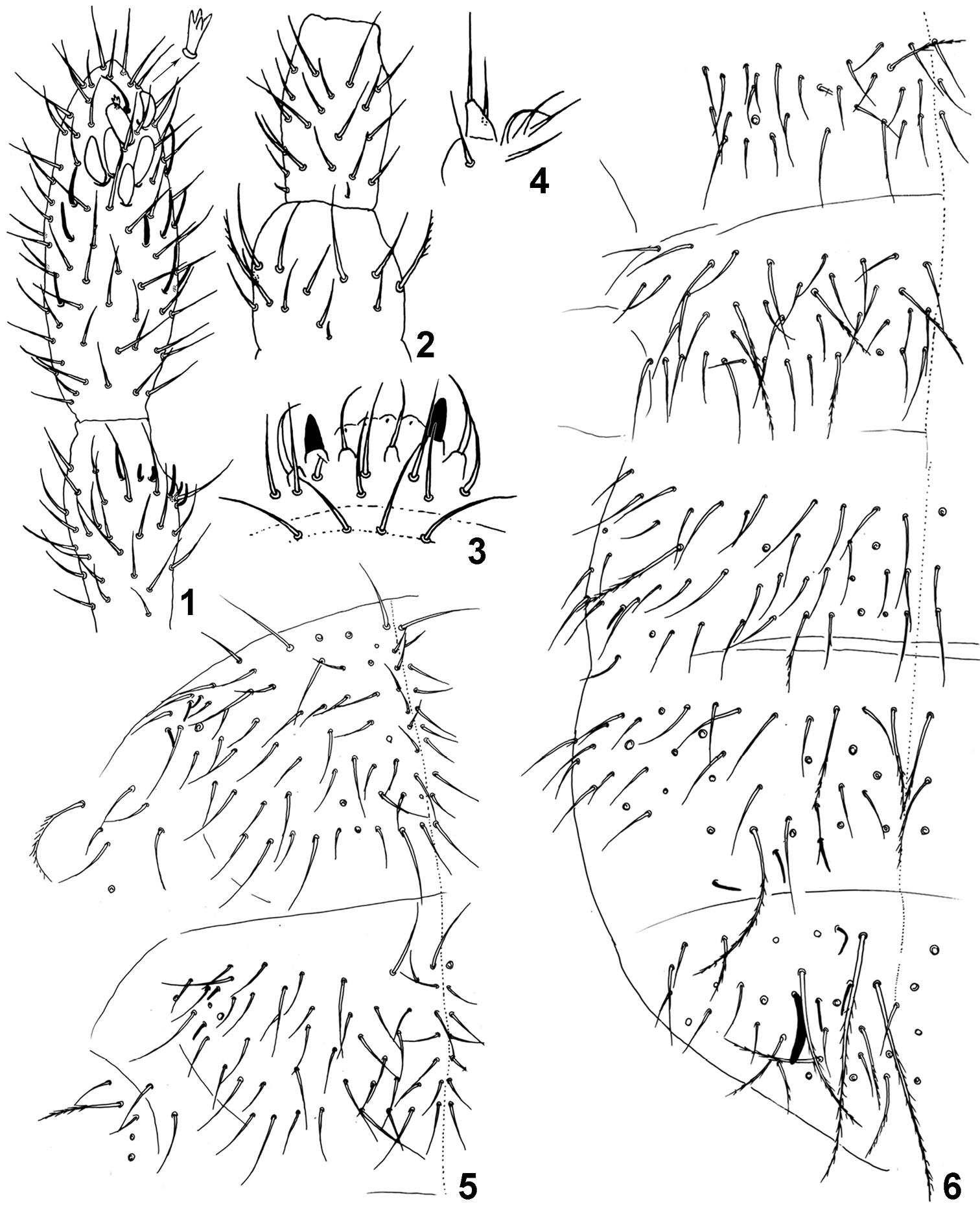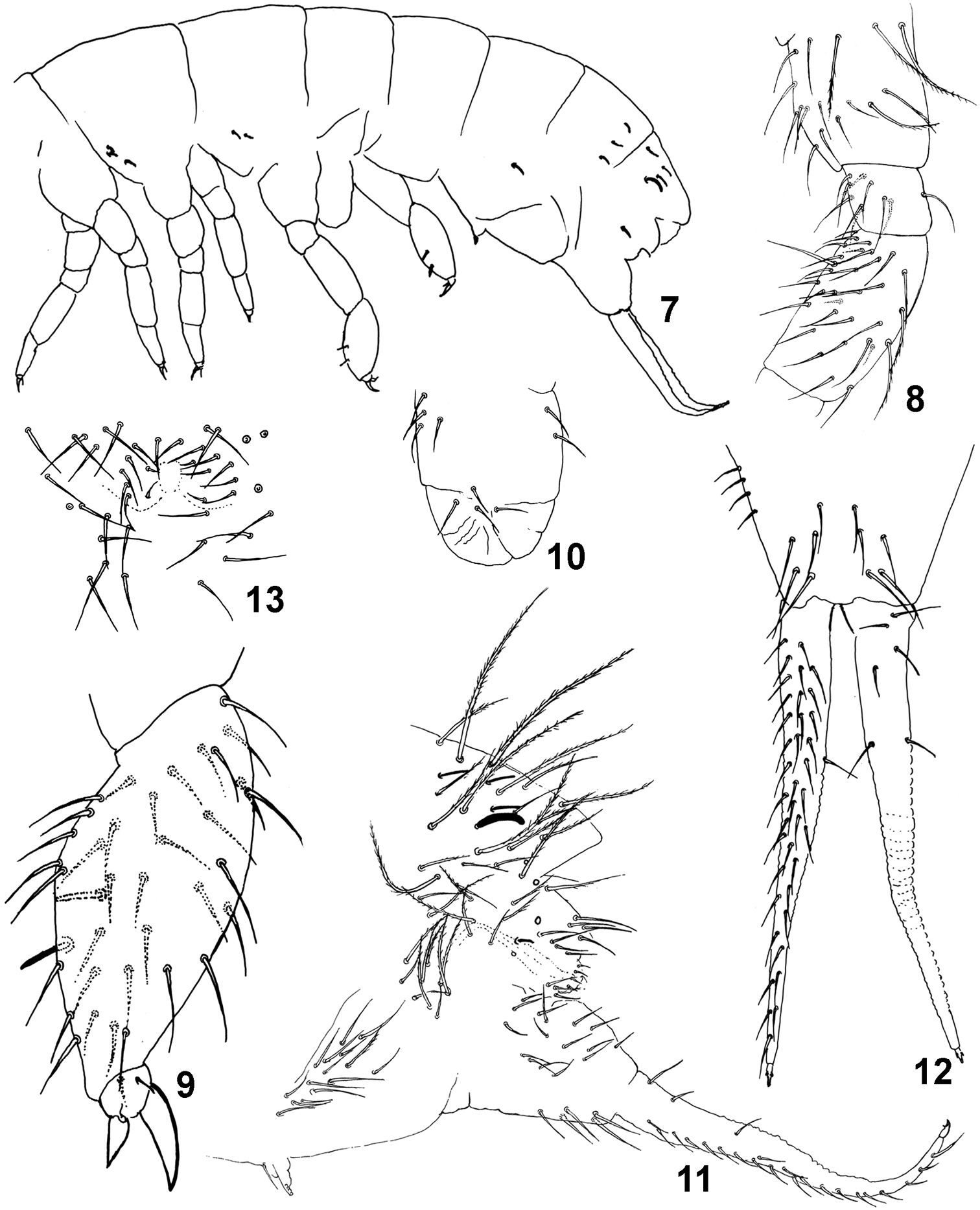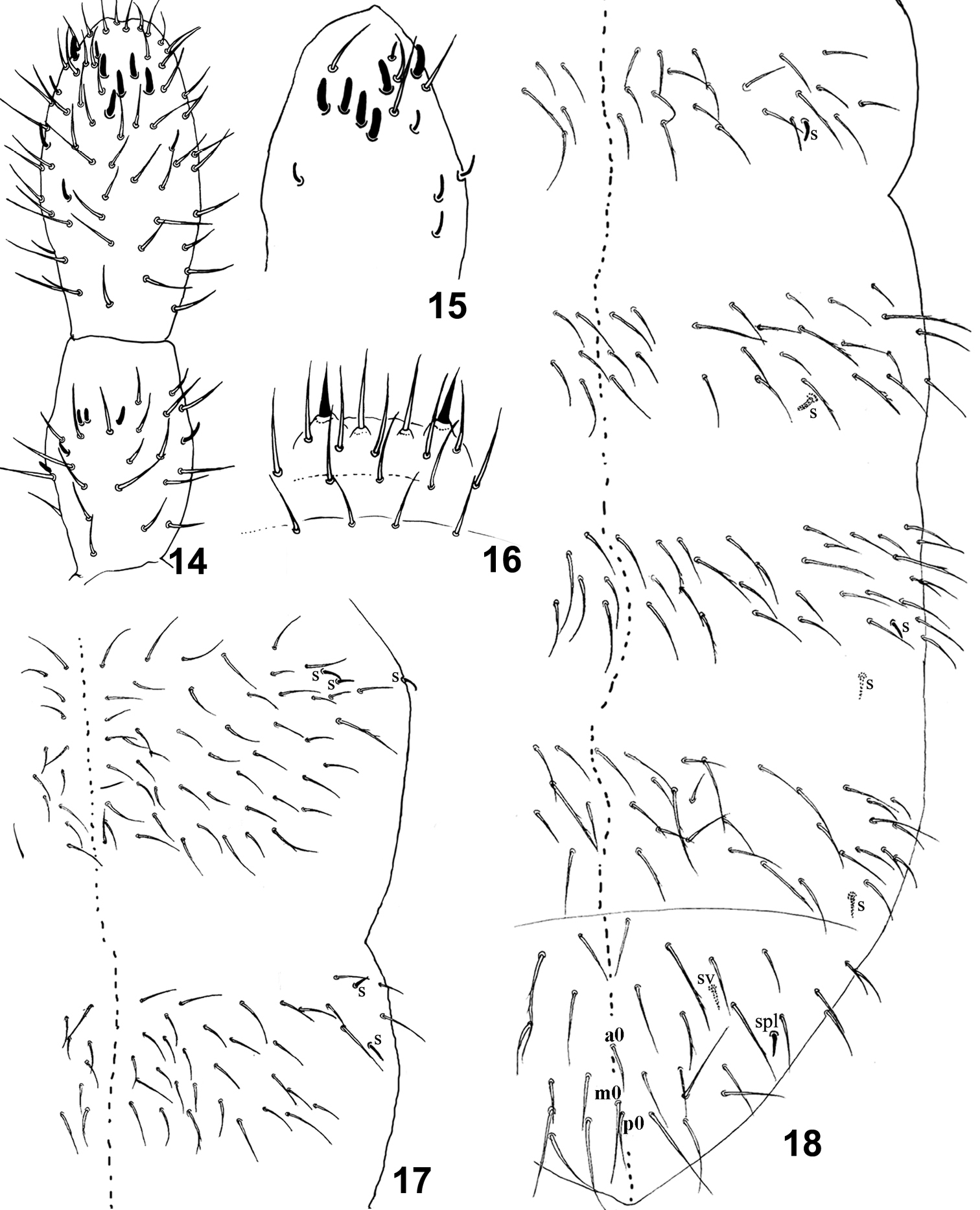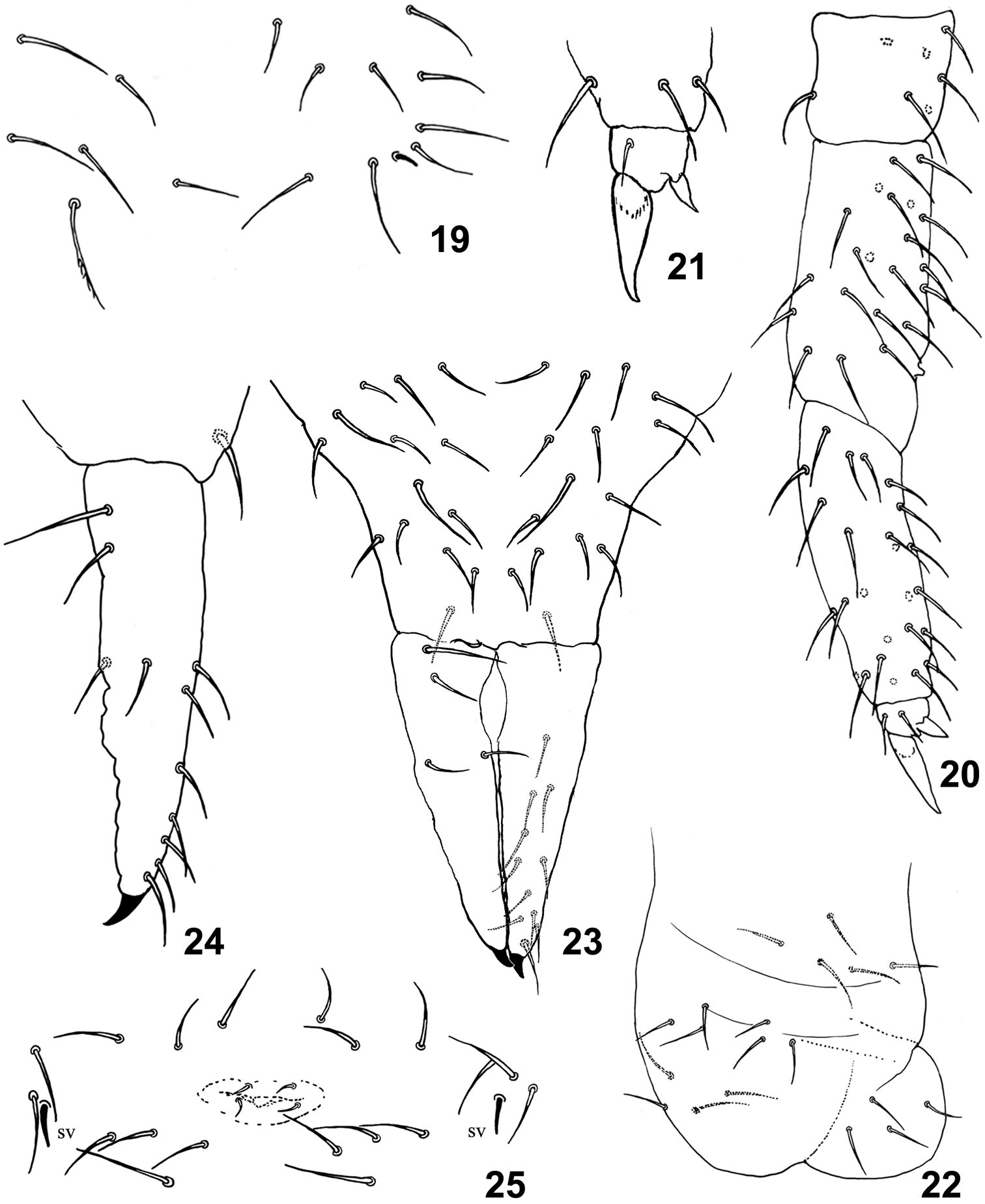






(C) 2012 Maria Cleide de Mendonça. This is an open access article distributed under the terms of the Creative Commons Attribution License 3.0 (CC-BY), which permits unrestricted use, distribution, and reproduction in any medium, provided the original author and source are credited.
For reference, use of the paginated PDF or printed version of this article is recommended.
Two new species of the genus Isotomiella Bagnall, 1939 are described and illustrated, the first: Isotomiella macedoi sp. n., based on males and females, from the “Parque Nacional da Serra dos Órgãos” (Teresópolis municipality, State of Rio de Janeiro) differs from the other by tibiotarsus III thickened and blunt and two antero-lateral chaetae of labrum strongly thickened. The second species Isotomiella uai sp. n. from “Serra da Gandarela”, (Caeté municipality, State of Minas Gerais) differs from the other by presence of short sensilla on antennal IV and tergites, two anterolabral chaetae thickened and falcate mucro.
Anurophorinae, Atlantic Rain Forest, Brazilian collembolan diversity, Taxonomy
Isotomiella comprises so far a reduced number of species for a genus considerably diverse, especially in tropical and subtropical regions. This can be attributed to the aspect of its members, all white and small, that look at first sight identical. Nowadays, the genus comprises 49 species, of which 18 were described from Brazil (
The specimens studied were collected in litter and soil, extracted with Berlese-Tullgren funnels and mounted in glass slides according with the usual methodology. The type-material has been deposited in the Collembola Collection at the Departamento de Entomologia, Museu Nacional, Rio de Janeiro (CM/MNRJ).
Abbreviations used in descriptionsAnt–antennal segment, Th–thoracic segment, Abd– abdominal segment, sl– lateral sensillum, sv– ventral sensillum, spl–dorsal lateral sensillum.
Data resourcesThe data underpinning the analyses reported in this paper are deposited in the Dryad Data Repository at doi: 10.5061/dryad.m966q
Taxonomyurn:lsid:zoobank.org:act:48E60458-A1F8-4C63-9C6B-28CA3F6A8724
http://species-id.net/wiki/Isotomiella_macedoi
Figs 1–13Holotype: Male (2320 CM/MNRJ): Southeast Brazil, State of Rio de Janeiro, Teresópolis municipality, Rain forest litter at 1.400 meters a.s.l., 14-III-2012. Mendonça, M.C. leg. One Paratype male, same data as holotype, One male and 12 Paratypes female (2364CM/MNRJ) Same locality of holotype. 31-V-2012. All material deposited in Collembola Collection of Museu Nacional da Universidade Federal do Rio de Janeiro (Brazil).
Total body length of the holotype 0, 74 mm. Habitus typical of the genus. Color white. Integument without craters. Pseudopores and integument channels not observed.
Antennae subequal to head diagonal. Length of Ant I to IV (30 µm, 40 µm, 40 µm, 65 µm). Ant IV with one conspicuous tulip-shaped microsensillum with three or four small spines at apex protected by a curved chaeta, six broad and subequal sensilla, eight supplementary very thin sensilla (seven dorsal external, six dorsal internal and one shorter and thicker dorsal). Ant III with about 35-40 ordinary chaetae, two small sensory rods (3 µm), three guard sensilla (7 µm) and one short sensillum below (Fig. 1). Ant II with about 40 smooth ordinary chaetae, 2 basal microsensilla, one dorsal and one ventral, and one dorso-lateral sensillum (Fig. 2). Ant I with 14 smooth ordinary chaetae, two lateral ciliated chaetae, two ventral and unequal sensilla (10 µm and 4 µm) and two basal microsensilla, one dorsal and one ventral. Labral chaetae pattern 4/5, 5, 4, the third row with two lateral acuminate chaetae and the last row with two anterolateral chaetae strongly thickened (Fig. 3). External lobe of maxilla with bifurcate palp and four sublobal chaetae (Fig. 4). All chaetae of head smooth. Axial chaetotaxy pattern from Th II to Abd IV as 20, 14/6, 6, 6, 6 by half tergite. Th II with 1+1 lateral ciliated macrochaetae (45 µm) and 3+3 lateral sensilla (5 µm). Th III with 1+1 lateral ciliated macrochaetae (50 µm) and 2+2 lateral sensilla (5 µm); all the other chaetae smooth (Fig. 5). Abd I with 1+1 lateral ciliated macrochaetae (40 µm) and 2+2 ciliated chaetae (30 µm) between the lateral macrochaetae; sensilla absent. Abd II with 1+1 lateral ciliated macrochaetae (40 µm) and 2+2 ciliated chaetae between lateral macrochaetae; sensilla absent and without the lateral area devoid of chaetae. Abd III with 2+2 anterior ciliated chaetae (35 µm) and 2+2 posterior ciliated chaetae (35 µm ) between the lateral ciliated macrochaetae (40 µm), 1+1 ventral sensillum (5 µm). Abd IV with many ciliated chaetae (35-50 µm) and few smooth chaetae, 3+3 posterior sensilla (11 µm). Abd V-VI with several ciliated macrochaetae of different sizes (60-75 µm) and few smooth chaetae, 1+1 long and thick dorso-lateral sensillum (spl) with apex slightly curved (20 µm), 3+3 dorso-lateral sensilla sa, spe, spi (11 µm) and 1+1 ventral sensillum sv (5 µm) (Fig. 6). Dorso-lateral sensillary pattern of the body 3, 2/0, 0, 1, 2, 5 (Fig. 7) Subcoxa I of legs I, II, III with 2, 3, 2 ciliated chaetae. Femur III with tenent hair smooth and two ciliated chaetae (Fig. 8). Tibiotarsus III strongly thickened on males, with about 40 smooth chaetae and 2 thin erect stick-like chaetae (10 µm); on females the tibiotarsus III are normal without stick-like chaetae. Unguis plump (20 µm) and unguiculus (10 µm) lanceolated (Fig. 9). Ventral tube (45 µm) with 4+4 anterior, 2+2 posterior and 4+4 distal chaetae (Fig. 10). Tenaculum with 4+4 teeth and 1 chaeta. Subcoxae anterior with 15 chaetae of which one ciliated; subcoxae posterior with 9 chaetae of which 6 ciliated (Fig. 11). Manubrium (55 µm) with 5+5 ventro-distal, 4+4 lateral, and 12+12 dorsal smooth chaetae. Dens long, (125-130 µm) crenulated, with about 40 anterior and 6 posterior smooth chaetae. Mucro small (7 µm), tridentate, the 2 basal teeth symmetrical (Fig. 11-12). Male genital plate as in Fig. 13.
Isotomiella macedoi sp. n. is easily included in the minor group sensu
The species is dedicated to the husband of the senior author, Prof. Antonio Carlos M. Macedo, micropaleontologist.
Isotomiella macedoi sp.n. 1 Ant III-IV Dorsal view, detail of the apical microsensillum 2 Ant I-II Dorsal view 3 Labral and prelabral chaetae 4 Outer lobe of maxilla 5 Dorsal chaetotaxy of Th II-III 6 Dorsal chaetotaxy of Abd I-VI.
Isotomiella macedoi sp.n. 7 Sensillary pattern of the body 8 Subcoxa and femur of leg III 9 Tibiotarsus and unguis of leg III 10 Lateral view of ventral tube 11 Lateral view of abd. V-VI, subcoxa furcal, furca and tenaculum 12 Furca 13 Male genital plate.
urn:lsid:zoobank.org:act:7DE12EBF-102F-4604-B46F-6C81C7688F11
http://species-id.net/wiki/Isotomiella_uai
Figs 14–25Holotype: Female (2109CM/MNRJ), Southeast Brazil, State of Minas Gerais, Caeté municipality, Rain forest litter with about 1.500 meters a.s.l., 09. VII. 2011, Abrantes, EA and Silveira, TC leg.
Paratype: five females (2109CM/MNRJ) and six females (2110CM/MNRJ) same data as holotype, all material deposited in Collembola Collection of Museu Nacional da Universidade Federal do Rio de Janeiro, (Brazil).
Body length size 0, 77–0, 97mm. Habitus typical of the genus. Color white. Integument dorsally without craters, with primary granules. Pseudopores and integument channels not observed. Antennae subequal to head diagonal. Length of Ant I to IV (30 µm, 35 µm, 39 µm, 58 µm). Ant IV with one microsensillum protected by a curved chaeta, six small and subequal sensilla (5 µm), supplementary very thin sensilla (3-4 dorsal lateral external and one dorsal internal) (Figs 14-15). Ant III with 26 ordinary chaetae, two very small sensory rods (2 µm), three small guard sensilla (3 µm), one below short sensillum and one lateral internal additional sensillum (Fig. 14). Ant II with 23-24 smooth ordinary chaetae, two basal microsensilla (one dorsal lateral and one ventral lateral) and one microsensillum lateral external. Ant I with about 13 dorsal ordinary chaetae, two ventral and unequal sensilla (5 µm and 3 µm) and two basal microsensilla (one ventral and one dorsal). Labral chaetae pattern 4/5, 5, 4, four very little anterior spinules; two antero lateral chaetae of labrum (11 µm) thickened with apical filament (Fig. 16). External lobe of maxilla with bifurcate palp and 3 sublobal chaetae. All chaetae of head smooth. Axial chaetotaxy pattern from Th II to Abd IV with 8-10, 5/3, 3, 3, 3 by half tergite (Figs 17, 18). Th II with 1+1 lateral macrochaetae slightly ciliated (22 µm) and 3+3 lateral sensilla, sl 3 (5 µm) migrated far from the others two (5 µm and 3 µm); Th III with 1+1 lateral slightly ciliated macrochaetae (22 µm) and 2+2 lateral sensilla (5 µm) (Fig. 17). Abd I with 1+1 lateral slightly ciliated chaetae (17 µm) and 1+1 sensillum (4 µm); Abd II with 1+1 lateral slightly ciliated macrochaetae (22 µm), 1+1 ventral-lateral sensillum, without area devoid of chaetae (Figs 18, 19). Abd III with 1+1 slightly ciliated macrochaetae (22 µm), few slightly ciliated chaetae (18 µm) and 2+2 sensilla (5 µm), one dorso-lateral and one ventral. Abd IV with 2+2 ciliated macrochaetae (23 µm) and 1+1 ventral-lateral sensilla (7 µm). Abd V-VI with some slightly ciliated (30 µm) and some smooth macrochaetae; 1+1 dorso-lateral sensillum spl, short and thin (5 µm); 1+1 ventral sensillum sv (6 µm) and unpaired chaetae smooth, ao (15 µm), mo (19 µm) and po (20 µm) (Fig. 18).
Proximal whorl of tibiotarsi with seven chaetae (Fig. 20). Tibiotarsus III without tenent hair or thickened apical chaetae. Unguis thin and toothless (15 µm), unguiculus lanceolate (5 µm) (Figs 20, 21). Ventral tube with 3+3 anterior, 4-5 posterior and 4+4 distal chaetae (Fig. 22). Tenaculum with 4+4 teeth and one chaeta. Subcoxae anterior with seven chaetae of which one ciliated; subcoxae posterior with seven chaetae, of which one ciliated. Manubrium (55 µm) with 1+1 ventro-distal and 14+14 dorsal chaetae, without lateral chaetae (Fig. 23). Dens longer than manubrium (65 µm), slightly crenulated, with 10+10 – 13+13 anterior and 4+4 posterior chaetae. Mucro small and falcate (5 µm) (Fig. 23, 24). Female genital plate as in Figure 25.
Isotomiella uai sp. n.belongs to the nummulifer group sensu
The species is dedicated to the people of Minas Gerais by the unique and local interjection “uai” used by its inhabitants.
Isotomiella uaisp.n. 14 Ant III-IV Dorsal view 15 Sensillary pattern of Ant IV 16 Labral chaetae 17 Dorsal chaetotaxy of Th II-III 18 Dorsal chaetotaxy of Abd I-VI.
Isotomiella uai sp.n. 19 Detail of chaetotaxy of Abd II 20 Leg III 21 Unguis of leg III 22 Ventral tube 23 Furca 24 Lateral view of dens and mucro 25 Female genital opening.
We are thankful to our colleague PhD Student Gabriel Costa Queiroz for the critical review and suggestions of the first manuscript, to both anonymous reviewers, to “AMPLO Consultoria”, specially Biologist Lucas Ribeiro, for the logistic support to the sampling in the State of Minas Gerais and to FUJB (Fundação Universitária José Bonifácio) for the equipment support. Open access to this paper was supported by the Encyclopedia of Life (EOL) Open Access Support Project (EOASP).



